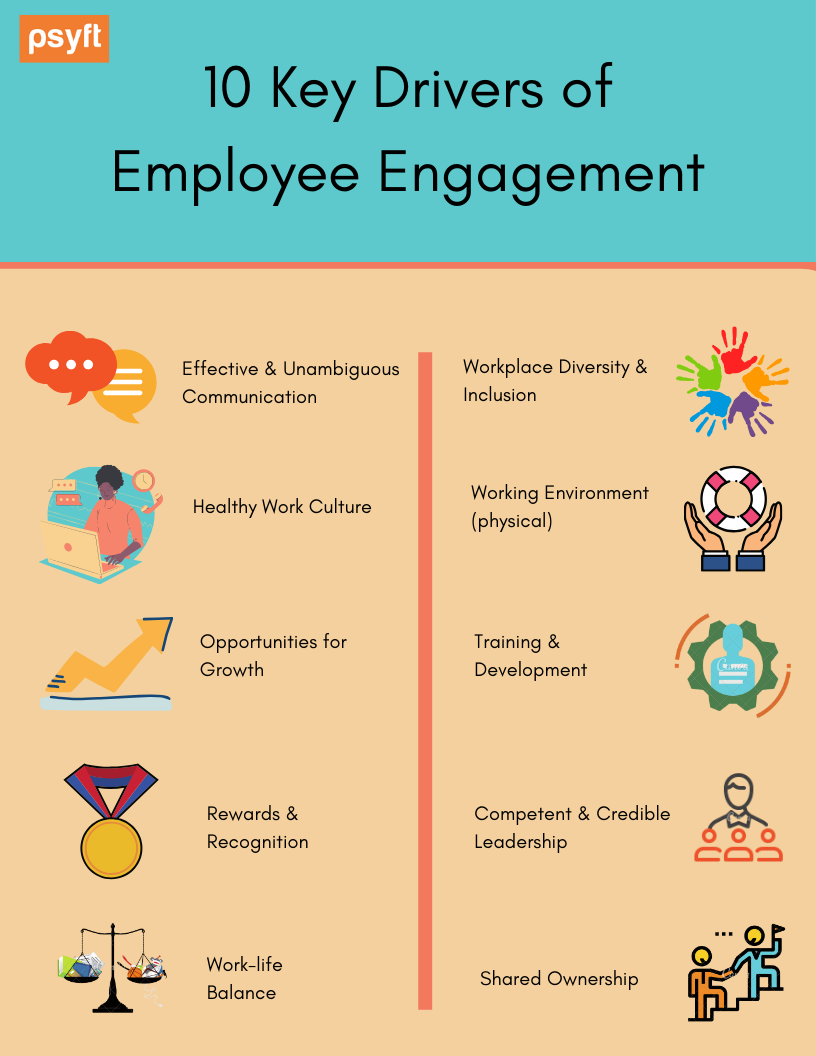Blogs
Get latest insights on what's trending in the HR world - Talent Search, Talent Assessments, Psychometrics, Employee Engagement, Appraisals & much more.

Disengaged Employees: How to Spot & Re-Engage Them
02nd August 2022
Disengagement in employees is defined as a “lack of will to put in the extra effort to achieve success”. Disengaged employees are not bad performers. In fact, they are almost always great performers who lose interest in work over time, are easily distracted for long periods and have minimal output as a result of decreased productivity. Their negative attitude towards their work and the organization are critical causes of fall in organizational productivity and success.
Disengagement affects your bottom line in many ways, resulting in a net loss of $450-$550 billion dollars* every year. This means a net loss of over a quarter million per year for a company with 100 employees, out of which 15% are disengaged.
A well-known example of organizational distress due to employee disengagement would be the case of Boeing*. In the late 1990s - early 2000s, the aircraft manufacturer felt very real repercussions of employee discontent arising out of large scale layoffs, heavy outsourcing of jobs, relentless cost-cutting and a dizzying pace of change. Four waves of employee surveys documented widespread feelings of betrayal among the workforce. Disengagement affected every level of the organization and altered the organizational culture. One of the most notable shifts was that from a feeling of shared experience and respect among employees and management to a sense of disenchantment. People began to distance themselves emotionally from the company they had once admired and considered family. It took the company more than a decade to fully recover from the resentment.
More recently the business world is dealing with a trend of mass resignations post Covid. This mass disengagement at work may be due to announcements regarding return-to-office or re-prioritizing of individual goals like personal happiness, more money or mental health crises faced especially by frontline workers in hospitality and healthcare industries globally.
Top indicators of disengaged employees:
-
Lack of Customer Satisfaction:
Low customer ratings for an employee may be a sign of employee disengagement and needs to be looked into. Poor quality and quantity of work over time is a clear indicator of disengagement in employees.
-
Constant Employee Complaints:
Disengaged employees may consistently keep complaining about their work environment, supervisors, team, projects, customers, company etc. These may not be baseless and need to be investigated immediately as they may influence other employees as well.
-
Changes in productivity:
Refusal to do certain tasks or taking short-cuts in work on a regular basis are clear indicators of disengagement in employees.
-
Absenteeism and lack of punctuality:
Coming late to work, leaving office at random times or consistently taking off from work are also signs of disengaged employees.
-
Lack of self-improvement
Disengaged employees see no point in seizing opportunities for career development and taking initiative to improve themselves.
-
Active Disengagement:
This is an even more toxic problem than disengagement in employees. The actively disengaged employees spread negativity in a workplace and act out their unhappiness against their company, managers and team, which constantly undercuts the progress made by their engaged coworkers. Their negativity and cynicism is bound to further dishearten already disengaged coworkers as well as engaged ones.
Reasons for Employee Disengagement:
Disengagement is a gradual process where employees feel a lack of motivation to do their work. There can be several factors leading to disengagement in your employees.
-
Poor Relationships in Work Area:
If the employees do not get along with their co-workers and team members they become disengaged over time.
-
Work Flexibility and Autonomy:
Lack of flexibility in terms of current work projects or working hours may also cause dissatisfaction among employees. Constant micro-management by supervisors or feeling of having no control over “how” they work may result in disengagement in work too. Recent surveys indicate that more than 66% of Indian professionals report higher employee satisfaction working remotely and approximately 70% of IT companies in India are trying to make the hybrid model work permanently.
-
All employees want to know about their progress at work. Lack of consistent, constructive feedback is one of major reasons for employee disengagement. An employee may also miss opportunities to develop oneself due to a lack of effective feedback.
-
Lack of Communication:
Another leading cause of employee disengagement is lack of open, honest and clear communication. Infact, more than 80% of the employees globally feel that their companies lack transparency in communication.
-
Lack of Recognition:
Being recognized and appreciated for one’s efforts is a basic human need. Organizations need to personalize their recognition programs based on their employee preferences so as to minimize disengagement.
-
Dissatisfaction with Salary and other Benefits:
If employees feel that the compensation that they receive for the efforts they put in is unfair or that as they move up the hierarchy in an organization the benefits they receive do not match their position or efforts, may lead to dissatisfaction and disengagement.
-
Lack of Necessary Resources:
Research indicates approximately 75% of the employees feel that lack of resources, whether in terms of technology or other infrastructure, is the reason they are unable to achieve their full potential which ultimately leads to frustration and disengagement.
-
Lack of Leadership:
An employee looks up to his superiors be it immediate supervisor or the entire management team. If the trust of the employee is broken in their supervisor or management disengagement may follow.
-
Lack of sense of Purpose:
Each employee wants their work to contribute to overall organizational success. This gives them a sense of worth. However, if they feel their work is meaningless to the overall growth of their company they may lose motivation to work productively.
-
Lack of Employee Well-being:
Another contributing factor in employee disengagement is when employees feel that their employers do not care for their mental, physical or emotional well-being and are not interested in their cultural or social initiatives.
How to Handle and Re-engage Disengaged Employees?
Disengagement is an issue that requires to be addressed seriously and honestly by the management. Most of the disengaged employees may only require adequate time invested by you to handle their disengagement. Following are some tips to handle disengaged employees:
-
Make Time:
Healthy and engaged office demands open channels of communication and feedback. This means disengaged employees should be spoken to individually about their problems. This communication cannot be a one-time thing. Things need to be monitored regularly rather than a one-time meeting. The employees should feel that they are being heard and able to express their problems without fear of being penalized.
-
Address the Problem Head-on:
Disengaged employees need individual attention that means setting up a one-on-one meeting to speak about their behaviour. They need to be explained clearly and calmly the agenda of the meeting, by skipping small talk to understand the root cause of their disengagement. Once the issue is understood, the reason behind disengagement can be solved amicably.
-
Listen Carefully:
The employees should feel that they are being heard and their opinions matter. When engaging in one-on-ones with disengaged employees, they should be given a chance to do most talking. For regular feedback and employee opinions, employee engagement surveys can be conducted with the help of professional experts like Greenthumbs. These send a positive message to employees that they have a voice and their opinions matter.
-
Create a Personal Development Plan:
Employees need to be shown that their company cares about them and are invested in their success. Managers can ask the disengaged employees how they want to grow and the skill set they want to develop. Based on this feedback an action plan containing short-term and long-term goals can be created and ample opportunities for professional development in the form of webinars, conferences and training sessions can be given.
-
Conducting Regular 360-degree feedback:
It’s often said that people don’t leave their jobs, they leave their managers. Dissatisfaction with managers is a leading cause of employee disengagement and attrition. 360-degree feedback method is a great way to track how employees feel about their managers. This kind of feedback helps employees to articulate their satisfaction/discontent and it helps managers to understand and plug their blind spots. It’s a great way to boost productivity and engagement at the team level.
-
Sharing Feedback of the Meeting and employee accountability:
The manager handling the disengaged employee should send minutes of their meeting along with an action plan decided and consequences of failure in meeting the action plan which are pre-decided in the meeting. Creating action plans along with the employees is not enough. They need to be monitored and given a time-line to achieve this action plan.
-
Re-alingning Individual and Organizational Goals::
Most of the time disengagement in employees may occur due to lack of direction and purpose as they may feel that their job has no impact on their organization’s success. A simple way of re-motivating disengaged employees is to help them redefine their individual goals with the company’s goals. This will help reorient themselves and move in a direction congruent to company’s goals.
-
Using strength-based approach:
Focusing on making growth and development plans based on the unique strengths of the employees will boost their confidence. With this confidence, they will further want to enhance their skill set and work on areas that need improvement.
-
Providing a Mentor:
Having a constant guide who looks out for the employee and guides them in their endeavours may become a key factor in re-engaging the said employee. Through this sort of relationship, disengaged employees will have a sense of direction and purpose to fulfill.
-
Recognizing Efforts:
One of the easiest ways of boosting employee morale is to recognize the efforts put in by the employees. It could be as simple as saying “great job” or a “thank you” to a worker and subsequently awarding the top performers rewards for their performance.
-
Redefining Workplace Flexibility:
Many employees may disengage to circumstances in their personal lives. Managers when deciphering the causes of disengagement in one-on-one meetings, can ask the employees for clarity on such matters. Work from home options or flexibility in working hours can then be offered as solutions which will also lead to reduced attrition.
-
Make room for Leisure activities:
To foster better interpersonal relationships and work area friendships, team building activities and socializing need to be encouraged. This down-time will also lead to trust building and facilitate open communication. Employees will be able to come out of rut and engage more positively.
-
Re-evaluating Employees and their current job:
A major cause of disengagement in employees may be that they simply do not fit in their current jobs and thus, are demotivated no matter how much effort they put in. Suggesting internal transfers or a different project based on their strengths will help them re-engage at their workplace.
Improving communication in a workplace is the fundamental factor to increase employee engagement. Employee engagement surveys are often the most cost and time efficient method of gathering employee opinions regularly. The more regular the feedback, the more prepared is an organization to reverse disengagement.
Recent Articles
- When Everyone Wants WFH - Tips To Manage An Expanding Team Of Remote Employees
- 5 Proven Strategies To Retain Your Best Talent In 2022
- Why Organizations Should Take Exit Surveys Seriously
- How To Create A Culture Of Recognition In The Workplace
- Why Manager Effectiveness Survey Is Important For A Workplace
News Center
- India Today - 7 reasons companies ask for psychometric tests
- Business World - AI - The New Secret Sauce in Psychometric Assessments
- DNA - HR Trends for 2018
- The Hindu - Psychometric Assessment a "game changer" in hiring
- Entrepreneur - 9 ways to promote actionable feedback at organisations
- Human Capital - Looking Beyond Performance Appraisals





